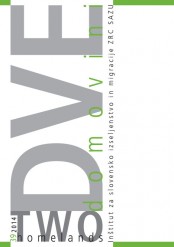Digital Heritage: Co-Historicity and the Multicultural Heritage of Former Yugoslavia
Keywords:
digital heritage, co-historicity, digital storytelling, migrationAbstract
The author discusses digital practices of preserving and representing multicultural heritage, first against the backdrop of dominant, official and often (nationally) exclusivist practices of “doing heritage”. The former are understood as tools for preserving, developing and embedding cultural heritage in wider experiential spaces, while the latter often serve as the tool for homogenisation and sanitisation of na- tional cultural and social spaces. To do this, the author focuses on presences and absences of WWII, socialist Yugoslav and post-Yugoslav migrant heritages in contemporary Slovenian digital spaces, i.e. how digital media are used to present and preserve these variegated heritages. In order to interrogate the practices and strategies of defining and managing heritage in the digital media environment, the author discusses several vernacular interventions as re-presences of the Yugoslav past. With respect to the specificities of the techno-cultural environment in which the topic “lives”, the author introduces the concept of“co-historicity” to denote the ways affective media practices facilitate contemporaneous “be- ing” in different, individualised, mediated and mediatised re-presences of the past.
Downloads
References
About us, Europeana Professional, http://pro.europeana.eu/web/guest/about (9 Sept. 2013).
Anderson, Benedict (1991). Imagined Communities: Reflections on the Origin and Spread of Nationalism. Revised edition. London and New York: Verso.
Anderson, Chris (2004). The Long Tail. Wired, www.wired.com/wired/archive/12.10/tail.html (18 Aug. 2013).
Assmann, Aleida (2009). Canon and Archive. Cultural Memory Studies: An International and Interdisciplinary Handbook (eds. Astrid Erll, Ansgar Nunning). Berlin, New York: Walter de Gruyter, 97–108.
Briggs, Asa, Burke, Peter (2005). Social History of the Media: From Gutenberg to the Internet. Cambridge: Polity Press.
Čakija Noris, GA, http://www.youtube.com/watch?v=vIaTmELSe58 (8 Sept. 2013).
Cameron, Fiona, Kenderdine, Sarah (2010). Theorizing Digital Cultural Heritage. A Critical Discourse. Cambridge: MIT.
Carice, GojkoAjkula/MZP Video Produkcija, http://www.youtube.com/watch?v=rdeL1dY55ag (17 Aug. 2013).
Concept of Digital Heritage, UNESCO, http://www.unesco.org/new/en/communication-and-information/access-to-knowledge/preservation-of-documentary-heritage/digital-heritage/concept-ofdigital-heritage/ (25 Aug. 2013).
DEDI, Enciklopedija naravne in kulturne dediščine na Slovenskem, www.dedi.si (30 Aug. 2013).
Detinjstvo, Sećanja.com – detinjstvo u Jugoslaviji šezdesetih, sedamdesetih, osamdesetih, http://www. youtube.com/watch?v=yeJQFOhYoaE (12 Aug. 2013).
Digitalna kulturna dediščina, Mestna knjižnica Ljubljana, http://www.mklj.si/index.php/digitalna-kulturna-dediscina (1 Sept. 2013).
dLib.si, Digitalna knjižnica Slovenije, http://www.dlib.si/ (30 Aug. 2013).
Ernst, Wolfgang (2004). Art of the Archive, http://www.medienwissenschaft.hu-berlin.de/medientheorien/downloads/publikationen/ernst-art-of-the-archive.pdf (23 Aug. 2013).
Ernst, Wolfgang (2013). Digital Memory and the Archive. Minneapolis: University of Minnesota Press.
Europeana, www.europeana.eu (30 Aug. 2013).
GojkoAjkula/MZP Video Produkcija, http://www.youtube.com/user/GojkoAjkula (1 Sept. 2013).
Haskins, Ekaterina (2007). Between Archive and Participation: Public Memory in the Digital Age. Rhetoric Society Quarterly 37: 401–422.
Heritage in the Making, A site on heritage dynamics in the former Yugoslavia, http://heritageinthemaking.wordpress.com/ (23 Sept. 2013).
Huhtamo, Erkki, Parikka, Jussi (eds.) (2011). Media Archaeology, Approaches, Applications and Implications. Berkeley: University of California Press.
Huyssen, Andreas (1995). Twilight Memories: Marking Time in a Culture of Amnesia. New York, Routledge.
Internet Archive’s The Wayback Machine, http://archive.org/web (30. Avg. 2013)
Kletvice, GojkoAjkula/MZP Video Produkcija, http://www.youtube.com/watch?v=OKmn2xzLG_M (21. Avg. 2013).
KAMRA, Digitalizirana kulturna dediščina slovenskih pokrajin, www.kamra.si (30 Aug. 2013).
Lambert, Joe (2013). Digital Storytelling: Capturing Lives, Creating Community. New York: Routledge.
Lundby, Knut (ed.) (2008). Digital Storytelling, Mediatised Stories: Self-Representation in New Media. New York: Peter Lang.
Mladost, Sećanja.com – mladost u Jugoslaviji šezdesetih, sedamdesetih, osamdesetih, http://www.youtube.com/watch?v=yeJQFOhYoaE (12 Aug. 2013).
Mlekuž, Jernej (2008). Čapac.si, or on Burekalism and Its Bites. An Analysis of Selected Images of Immigrants and Their Descendants in Slovenian Media and Popular Culture. Dve domovini / Two homelands 28, 23–37.
O’Halloran, Kay L. (2011). Multimodal Discourse Analysis. Companion to Discourse (eds. Ken Hyland, Brian Paltridge). London and New York: Continuum.
Parikka, Jussi (2010). Insect Media. An Archaeology of Animals and Technology. Minneapolis: University of Minnesota Press.
Petrović, Tanja (2014). Multicultural Dynamics and Heritage (Re)Appropriation in Bela Krajina. Dve domovini / Two Homelands 39, 89–102.
Reading, Anna (2012). Globital Time: Time in the Digital Globalised Age. Time, Media, and Modernity (ed. Emily Keightley). Basingstoke: Palgrave, 143–164.
SecanjaCom, http://www.youtube.com/watch?v=bsa8xZ5uBk4 (12 Aug. 2013).
Smith, Laurajane (2006). Uses of Heritage. London, New York: Routledge.
Sobchack, Vivian (2011). Afterword: Archaeology and Re-presencing the Past. (2011). Media Archaeology, Approaches, Applications and Implications (eds. Erkki Huhtamo, Jussi Parikka). Berkeley: University of California Press, 323–333.
Urry, John (1995). Consuming Places. London, New York: Routledge.
Virilio, Paul, in conversation with Philippe Petit (1999). Politics of the Very Worst. New York: Semiotext(e).
What is Cultural Heritage? Institute for the Protection of Cultural Heritage of Slovenia, http://www.zvkds. si/en/ipchs/protection-cultural-heritage/about-cultural-heritage/what-cultural-heritage/ (24 Aug. 2013).
What is Cultural Heritage, http://www.cultureindevelopment.nl/Cultural_Heritage/What_is_Cultural_ Heritage (3 Sept. 2013).
WWII Heritage, http://www.worldwar2heritage.com/ (28 Aug. 2013).
Downloads
Published
How to Cite
Issue
Section
License

This work is licensed under a Creative Commons Attribution-NonCommercial-NoDerivatives 4.0 International License.
Authors guarantee that the work is their own original creation and does not infringe any statutory or common-law copyright or any proprietary right of any third party. In case of claims by third parties, authors commit their self to defend the interests of the publisher, and shall cover any potential costs.
More in: Submission chapter





